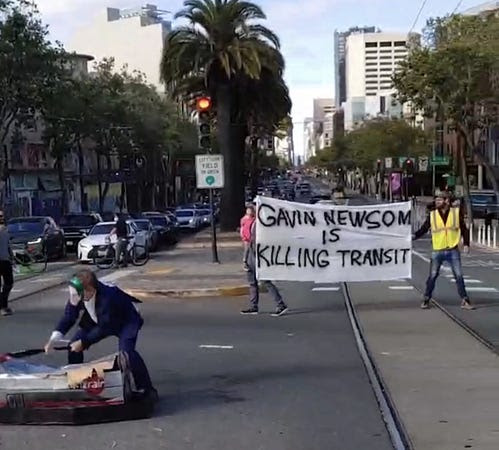Whether we’re talking about campaigns for transit funding, bike lanes, or anti-traffic violence infrastructure, issues-based campaigns are a little like fungi. They have a huge amount of activity going on beneath the surface, but most people only see the mushroom that “randomly” pops up above ground. People see the “Big Thing”: the highway blockade, the street theater, the protest, the die-in, the banner drop. But they often don’t see the increasingly-escalating actions and events that set the stage for the “Big Thing.”
While the “Big Thing” is the one of the most visible parts of the campaign, it’s not the whole campaign: it’s just another tool in the organizer toolbox. It serves a specific purpose, it meets a specific need, has various costs with it, and is most effective when deployed at a specific place & time and in a specific way. The “Big Thing” is a story within the overall campaign, and the story it tells needs to tie in to the rest of the overarching campaign narrative for it to be effective.
This can lead to a LOT of confusion for newer advocates who are planning their campaign strategy. The “Big Thing” can be a stumbling block for many advocates, since they often think that doing a “Big Thing” will win the day on its own, or that the “Big Thing” is what they should start with — or that they can’t win what they want because they don’t think they could ever pull off a “Big Thing.”
Instead of going straight for the “Big Thing”, sustainable transportation advocates should begin by 1) assessing your current situation, 2) solidifying your ultimate goal, and 3) identifying the strategically escalating steps of activity that get you from here to there. Who knows; you might be able to win what you want without the hassle of doing the “Big Thing” at all!
If your goal is to open a door, try the doorknob first before kicking it down.

So what are these steps of “Strategic Escalation” and how will you know when it’s time to take that next step?
1. Make the ask — then turn up the volume
To start off, make “the ask” of the decision maker in a friendly, respectful and straightforward manner. If they do what you’re asking of them — huzzah, you won! If not, then strategically escalate “the ask” by getting louder while maintaining the same tone.
When I say “get louder,” I mean get more people and groups to make “the ask” of the decision maker, so the decision maker really hears the message. Remember: escalate first by intensifying your volume, not the tone. Unless the decision maker gave a firm “no” to your ask, it’s best to start off assuming that they are on your side — or at least neutral — but haven’t quite gotten the message yet.
Think of it as “you and the decision maker against the problem.”Maintain that (public) attitude while you escalate, until it becomes obvious to everyone that the decision maker is refusing to deal with the problem, and thus has become part of the problem.

2. Increase the intensity
If, after you have escalated the volume and they remain silent, it is because they decided to be. Then it is time to escalate your volume and the intensity of your tone.
Intensify your tone by changing up your messaging and by embracing a wider range of tactics to highlight that the people are asking for XYZ and the decision maker is ignoring them. The decision maker’s inaction is now part of the problem.
3. Escalate the issue
At this point you will almost certainly get some sort of response from the decision maker. Depending on their response, you will either need to escalate by getting louder and getting more people speaking out, by making your message more intense with more activities highlighting the issue, or getting a little sharper in your tone. Most likely, you will need to do some combination of all three, but that combo varies depending on your specific situation — and your “Big Thing” will likely come into play then.
To be clear: you might be furious with the decision maker from the start, and that’s ok. There are lots of reasons to be mad! But unless that sentiment is widely shared, starting your campaign off with an intense adversarial tone will turn off more potential supporters then you will activate. For details on this particular point, check out “Using Your Anger Strategically to Win Bike & Bus Lanes”
As you get started on your push to make your community better, keep Strategic Escalation in mind and you will have an easier time. It’s not some flashy tactic: it’s a strategic way of thinking and operating.
Editor’s note: A version of this article originally appeared on Carter Lavin’s Substack and is republished with permission.
Carter Lavin is a climate activist in Oakland, California who helps organizations and individuals build political power, hone strategy, and win campaigns on the local, regional, and state level. Learn more about him at his website, or schedule a time to speak with him at carter@carterlavin.com.
Carter is also hosting the following free group trainings and virtual events:
–7/19 @ 5:30pm PT— Transit & Bike Activism Training: “How to win bigger by bridging the local and state-wide organizing gap.” Learn more and register here.
–7/26 @ 5:30pm PT— Join your fellow transportation advocates at the July Open Discussion Zoom Happy Hour! This month’s topic: “Translating Bike Joy into Bike Political Power.” Come share your thoughts and learn from allies. Register here.
-7/27 @ 5:30pm PT— Bike Activism Training: “A beginner’s guide to getting a protected bike lane in your community.” Learn more and register here.
The post How ‘Strategic Escalation’ Can Help Advocates Win Their Sustainable Transportation Goals appeared first on Streetsblog USA.
The post How ‘Strategic Escalation’ Can Help Advocates Win Their Sustainable Transportation Goals appeared first on Streetsblog California.






